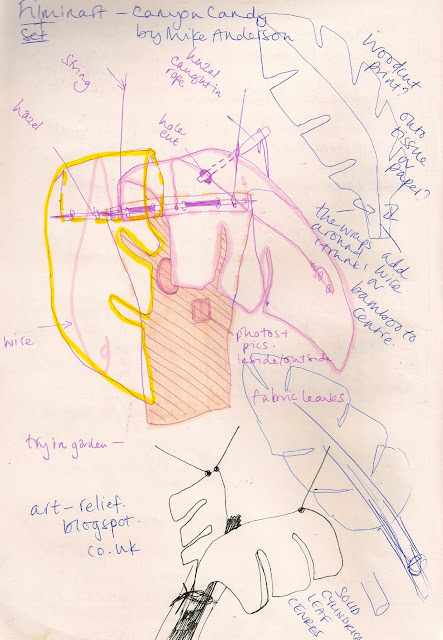I wanna make pragmatically beautiful instances of communication about our species' position in the natural world.
So I think there are probably three main reasons to choose certain sculptural or visual configurations, elements of materials.
1. aesthetics
2. message and connotations
3. materiality (largely this is because the artist themself is interested in the material, and enjoy working with it
I pick, in this order: 2, then 1, then 3.
And the shapes, arrangements, and elements I like are:
- thresholds,
- arches,
- pits,
- caves,
- tents and dens
- canopies and rooves
- sheltering structures of any sort
- drapery and swags of fabric
- and any arrangements that create or indicate a space for either flow/movement or remaining decidedly stationary/reflective/beings slow
- any arrangements that let you choose a path through a space, and sit down, lie down, jump, climb etc.
- stuff salvaged from skips that is big or intact enough to offer obvious re-use potential (card, wood, glass, bricks, fabric)
With all the above things, I want to learn to create narratives (pre-ordained or open-ended - but probs the former) with the help of
- absence
- space
- gaps
- presences
- ephemera
I don't much like Phyllida Barlow's attitude to her role as an artist, but I do like what she's said about why she likes making such large sculptures with hefty and hard to work with materials, about the fact that preliminary drawing are pretty useless and it's actually the making of the work that needs doing:
'Thinking and doing become synchronized. Time becomes a material"
She also said that the installing of her work is "a highly performative act". - This could be useful if I ever decide to communicate to an audience about waste and excess and our responsibility.
But one thing that Phyllida Barlow said that I think it bloody annoying is this:
"concern for the audience... attracting and audience... is something I find repellent"
Well then why did she ever say yes to her exhibitions in galleries? What a waste of an important public feedback platform, and an unbridled activism/demonstration/discussion opportunity.
I think her outlook is so disconnected from the concerns of real human life. And certainly now, we don't have the time or money (socially, economically or environmentally) to waste such massive exposure opportunities. If an artist is annoyed about audiences seeing their stuff, then I can't see how they can oppose the UK Government spending cuts in the arts.
I helped the Mexican artist Pedro Reyes on a project two years ago, and he said he liked his role as an exhibiting artist for it's opportunities to experiment with human behaviour and understanding. The exhibition space is the only place in the world where you can get away with just about anything that you couldn't get away with, or find the audience for, in everyday life. You have the chance to operate situations and suggest ideas for real life.
Anyway - there we are. More thinking about space, materials and audience.
I helped the Mexican artist Pedro Reyes on a project two years ago, and he said he liked his role as an exhibiting artist for it's opportunities to experiment with human behaviour and understanding. The exhibition space is the only place in the world where you can get away with just about anything that you couldn't get away with, or find the audience for, in everyday life. You have the chance to operate situations and suggest ideas for real life.
Anyway - there we are. More thinking about space, materials and audience.
 |
| Onion skin dyed found fabric, batik lettering |
The availability of the fabric here has dictated the shape and size of the piece. I've sewn bit together to create a canvas. It echoes an animal hide shape, and with the dye, the beeswax batik method and the sort of scratchy caveman-ish type, this sits in my imagination like a native American Indian entity.
 |
| Work in progress |
 |
| Shrivelled banana |
 |
| Flow |
 |
| Black bean screen |
 |
| sketches |
Above are some sketches for a sculptural thing i'm thinking up. It comes from a mix of tipi designs, banana leaves, insect anatomy and the practice of American Indian of gutting their dead ponies in winter, and carrying the hollow carcus on sticks on their shoulders across the wilderness, but with the tribe's kids inside the dead pony to keep them warm.







No comments:
Post a Comment